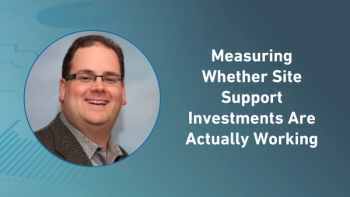
Veeva TMF Survey Reveals Industry Change
eTMF application use doubles amid industry-wide drive to improve inspection readiness and shorten clinical trial time
PHILADELPHIA, PA – Today, at the Drug Information Association’s (DIA) Annual Meeting, Veeva Systems reported the latest findings of the industry’s largest, annual global survey of trial master file (TMF) owners, the
Veeva 2016 Paperless TMF Survey
. The new research study reveals significant change is underway as the industry shifts from passive to active TMF management and adopts advanced electronic TMF (eTMF) applications to improve inspection readiness and shorten clinical trials.
Transition from passive to active TMF management accelerates
Maturity of TMF processes varies widely from passive TMF management – where TMF documents are simply stored and archived in file systems and other static repositories – to more advanced active TMF management – where purpose-built eTMF applications manage documents and processes in real-time as the TMF is being generated. Documents are created, reviewed, and acted upon in one system that is accessed by all study partners. Since the first Paperless TMF Survey in 2014, there has been a major shift from passive to active TMFs, as sponsors’ adoption of advanced eTMF applications has increased nearly twofold to 24%. Sponsors using local file systems as their eTMF dropped from 26% in 2014 to just 8% today. During the same period, clinical operations departments cut the use of paper for most or all TMF documents from 41% to 28%.
Sponsors move to unify systems, processes, and stakeholders
As life sciences companies move to more active TMFs, there is not only a marked reduction in paper and manual process in favor of electronic means to manage the TMF, but the use of centralized systems to collaborate with trial partners is also on the rise. One in four (23%) sponsors now use their eTMF application to share documents with CROs, up from 14% in 2014. Similarly, more sponsors use eTMF applications to exchange documents with sites (16%, up from 11% in 2014). On the heels of the MHRA’s mandate for TMF accessibility, the majority (80%) of sponsors using an eTMF application now provide remote access to inspectors and auditors or plan to do so within the next year. The clinical operations landscape remains highly fragmented with duplicate content and data in multiple systems across different functional areas and partners. Clinical leaders want full visibility and greater control, prompting rapid change toward unifying clinical operations for one process, one system, and one view. This is underscored by the growing demand to integrate eTMF applications with other clinical systems. Half (49%) of sponsors cite integration of their eTMF application with their clinical trial management system (CTMS) as a key need.
TMFs growing role in advancing clinical operations goals
Improving inspection-readiness and speeding study startup are the two most cited business benefits driving eTMF adoption among sponsors (67% and 53% respectively). Remote oversight of the TMF (48%) and better visibility into performance metrics (40%) also rate high as motivators for eTMF adoption. The data show the drivers prompting eTMF adoption are indeed the benefits realized by those using purpose-built eTMF applications. eTMF application users report significant improvements in several areas, including inspection readiness (61%), improved central and remote monitoring (59), and better visibility into performance metrics (55%). Users of other types of eTMFs, such as local or cloud file shares, are significantly less likely to see these benefits. When asked about the specific benefits in key inspection areas, nearly all (98%) respondents with an eTMF application saw major improvements in at least one area, including duplicate, missing, or incomplete documents. In addition, organizations that extensively use metrics to improve trial processes see more benefits than those who do not. These include improved audit and inspection readiness (67% vs. 29%), better visibility into performance metrics (53% vs. 14%), and cost savings (47% vs. 10%). Metrics also play an important part in speeding time to market. Respondents using an eTMF and extensively using metrics experienced faster study startup and shortened clinical time as compared to those not collecting data (20% vs. 5% and 23% vs. 5%, respectively). “eTMF applications are becoming an integral component of clinical operations as sponsors mature their TMF processes,” said Jennifer Goldsmith, senior vice president of Veeva Vault. “As the industry pushes toward unifying systems, processes, and stakeholders across clinical operations, the speed of clinical trial execution will continue to accelerate.”
In related news last week
, Veeva introduced the industry’s first true multitenant cloud solution for clinical trial management, Veeva Vault CTMS, to unify information, documentation, and processes across clinical operations globally. Together with Veeva Vault eTMF, Veeva will offer the first and only suite of clinical applications that combines CTMS and eTMF on one cloud platform to accelerate trial execution and gain real-time visibility into clinical operations.
Survey Methods
The survey consisted of 13 questions, many of which included sub-questions with response matrices. Survey questions were designed for individuals with knowledge of TMF document processes and with partial or full responsibility for a TMF within their organization. The survey was commissioned by Veeva Systems and conducted by Fierce Markets. Completion of the survey was voluntary, and a $5 donation was made to Doctors Without Borders for each valid completion of the full survey. All respondents were offered a summary of the survey results. No other compensation was offered or provided. The full results of the Veeva 2016 Paperless TMF Survey will be presented at the DIA 2016 Annual Meeting on Tuesday, June 28 at 3:25pm in the Innovation Theater, Exhibit Hall B. DIA attendees can also visit Veeva’s booth, #1308 for a copy of the executive summary.
Additional Information
For more on Veeva 2016 Paperless TMF Survey, visit:
veeva.com/TMFSurvey2016
For more on the Veeva suite of clinical products, visit:
veeva.com/clinical
Stay updated on the latest Veeva news on LinkedIn:
linkedin.com/company/veeva-systems
Follow @veevasystems on Twitter:
twitter.com/veevasystems
Like Veeva on Facebook:
facebook.com/veevasystems
About Veeva Systems
Veeva Systems Inc. is a leader in cloud-based software for the global life sciences industry. Committed to innovation, product excellence, and customer success, Veeva has more than 400 customers, ranging from the world's largest pharmaceutical companies to emerging biotechs. Veeva is headquartered in the San Francisco Bay Area, with offices in Europe, Asia, and Latin America. For more information, visit
www.veeva.com
.
Newsletter
Stay current in clinical research with Applied Clinical Trials, providing expert insights, regulatory updates, and practical strategies for successful clinical trial design and execution.




